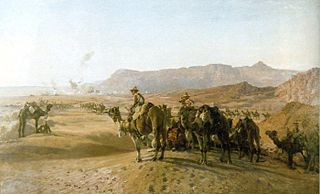
The Battle of Magdhaba took place on 23 December 1916 during the Defence of Egypt section of the Sinai and Palestine Campaign in the First World War. The attack by the Anzac Mounted Division took place against an entrenched Ottoman Army garrison to the south and east of Bir Lahfan in the Sinai desert, some 18–25 miles (29–40 km) inland from the Mediterranean coast. This Egyptian Expeditionary Force (EEF) victory against the Ottoman Empire garrison also secured the town of El Arish after the Ottoman garrison withdrew.
The Egyptian Expeditionary Force (EEF) was a British Empire military formation, formed on 10 March 1916 under the command of General Archibald Murray from the Mediterranean Expeditionary Force and the Force in Egypt (1914–15), at the beginning of the Sinai and Palestine Campaign of the First World War.

Sir Henry Somer Gullett KCMG CB was an Australian journalist, military historian and politician. He was a war correspondent during World War I and co-authored the official history of Australia's involvement in the war. He later served in federal parliament from 1925 to 1940 and held senior ministerial office.

Friedrich Siegmund Georg Freiherr Kress von Kressenstein was a German general from Nuremberg. He was a member of the group of German officers who assisted in the direction of the Ottoman Army during World War I. Kress von Kressenstein was part of the military mission of Otto Liman von Sanders to the Ottoman Empire, which arrived shortly before World War I broke out. He was also the main leader for the Ottoman Desert Command Force (DCF).
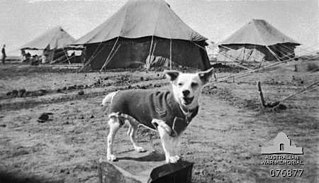
Horrie the Wog Dog was the unofficial mascot for the 2/1st Machine Gun Battalion of the Second Australian Imperial Force. An Egyptian terrier, the dog was befriended by a soldier serving in the unit when it was stationed in Egypt during the Second World War. The dog subsequently followed the battalion throughout various locations in the Middle East and in Greece and Crete, before being smuggled back to Australia in 1942. In 1945, the dog became the subject of a book by author Ion Idriess, and is believed to have been destroyed by quarantine officials, although this remains the subject of speculation with some researchers claiming that the dog survived after its owner switched it with another prior to destruction.

Ion Llewellyn Idriess was a prolific and influential Australian author. He wrote more than 50 books over 43 years between 1927 and 1969 – an average of one book every 10 months, and twice published three books in one year. His first book was Madman's Island, published in 1927 at the age of 38, and his last was written at the age of 79. Called Challenge of the North, it told of Idriess's ideas for developing the north of Australia.

Major Claude Scudamore Jarvis CMG OBE was a British colonial governor. As an Arabist and naturalist, he became noted for his knowledge of the desert Bedouin and for his rapport with them.

The Egyptian Camel Transport Corps were a group of Egyptian camel drivers who supported the British Army in Egypt during the First World War's Sinai and Palestine Campaign. The work done by the 170,000 men of the Corps helped British war operations in the Sinai desert and in Palestine and Syria by transporting supplies to the troops in extreme geographic and weather conditions.

William Maitland Woods was an Anglican clergyman and a military chaplain in Queensland, Australia.
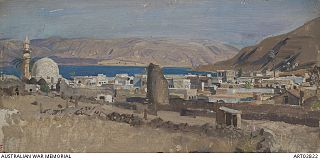
The Capture of Tiberias took place on 25 September 1918 during the Battle of Sharon which together with the Battle of Nablus formed the set piece Battle of Megiddo fought between 19 and 25 September in the last months of the Sinai and Palestine Campaign of the First World War. During the cavalry phase of the Battle of Sharon the Desert Mounted Corps occupied the Esdraelon Plain 40–50 miles (64–80 km) behind the front line in the Judean Hills. One squadron from each of the 3rd and 4th Light Horse Brigades Australian Mounted Division attacked and captured Tiberias, along with the Yildirim Army Group's Ottoman and German garrison.

The Desert Column was a First World War British Empire army corps which operated in the Sinai and Palestine Campaign from 22 December 1916. The Column was commanded by Lieutenant General Philip W. Chetwode and formed part of Eastern Force. When Chetwode took command of Eastern Force after the Second Battle of Gaza, Harry Chauvel took command and oversaw the expansion of the column to three divisions.

The Raid on Nekhl was the second of three battles by British forces to recapture the Sinai Peninsula during the Sinai and Palestine Campaign of World War I. Egyptian Expeditionary Force (EEF) mounted forces travelled into the centre of the Sinai Peninsula to attack and push the last Ottoman Army garrisons back into Palestine.

Madman's Island is a 1927 novel by Ion Idriess set in northern Australia.

Drums of Mer is a 1933 Australian novel by Ion Idriess set in the Torres Strait.

The Raid on Jifjafa was a long range pre-emptive operation by a composite formation of the British Empire against Ottoman forces at the Jifjafa well in the Sinai Desert. It was part of the Sinai and Palestine Campaign of World War I.
XIX Brigade, Royal Horse Artillery was a Royal Horse Artillery brigade of the Territorial Force that was formed by the Egyptian Expeditionary Force in Palestine in January 1917 for the Imperial Mounted Division. It served with the division thereafter in the Sinai and Palestine Campaign and was broken up after the end of World War I.

The Australian Guerilla series was a series of 6 handbooks published in World War II by Ion Idriess. Idriess had been a sniper during World War I. The books were written when Australia was under threat of invasion during World War II.
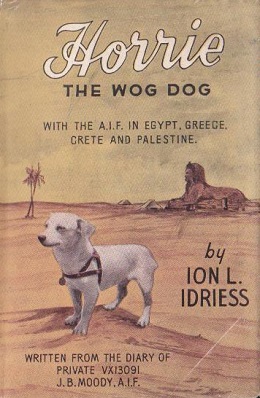
Horrie the Wog Dog is a 1945 book by Ion Idriess about the adventures of Horrie the Wog Dog, the Australian war mascot.
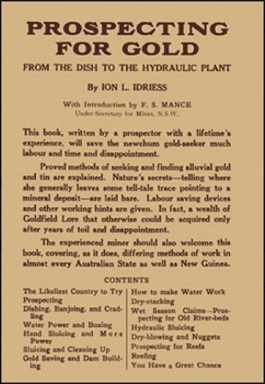
Prospecting for Gold is a 1931 non fiction book by Ion Idriess. It is a guide on how to prospect for gold.
There were five main arenas where Australian Great War Poetry was written in the period of 1914 to 1939: the Home Front, Gallipoli, The Middle East, The Western Front and England. These arenas were to form important segregations of poetic attitude and interest specific to the war mood at the time. Australian poets, just like their British counterparts, could be humorous, melancholy, angry or just longing for home. Many Australians, for example, wrote about the Australian flora, and how they missed it.
















